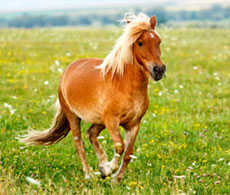
Horse nutrition advice for fussy eaters
What are the most common reasons for pernickety eating in horses and how can owners tackle it for a balanced diet and a healthy horse? Horse nutritionist Clare Barfoot has some useful answers and practical solutions.
My horse gets stressed when we travel to shows and won’t eat or drink. What can I do to tempt him?
-
Just like us, some horses get nervous, anxious or just plain excited to be away from home, and the first thing that suffers is their appetite. Make sure that your horse has access to forage while travelling and when at a show. Horses have evolved to eat for up to 18 hours a day and a sudden reduction in this can upset their digestive systems. Keeping your routine as normal as possible will help manage this risk and ensure a healthy horse.
If you’re only at a show for the day, you may not need to give a bucket feed, but if you’re staying overnight or need to give a lunchtime feed, stick to these golden rules of feeding:
- Don’t feed within one hour of exercise – longer if the exercise is going to be fast and/or strenuous.
- Try adding in your horse’s favourite fruit or vegetable to the horse feed to encourage eating, or even tempt him with the odd Polo.
- In the case of water, try adding sugar beet water to tempt your horse into keeping hydrated. However, first make sure he’s used to drinking this at home.
Whenever I add medication such as Bute or antibiotics to horse feed, my horses can smell it from a mile away and won’t go near it. How can I disguise the medication?
-
This can be really challenging, especially with antibiotics, as they’re often made up of a lot of powder. If your horse or pony normally only gets a small amount of feed, try adding in some extra chopped fibre, as it won’t cause any digestive problems and will help dilute the medication.
Adding in some of your horse’s favourite succulents, such as carrots and apples, may tempt him to eat. So, too, could mixing in a small amount of molasses, which disguises bad tastes and stops the powder from sticking to the inside of the bucket. Horses like the sweet taste of molasses, but bear in mind that the high sugar content means it’s not suitable for horses that are overweight and/or susceptible to laminitis.
If your horse really backs away from his bucket, you may have to ask your vet if it’s possible to get the medication in a tablet form, so that you can ‘hide’ the tablets in apples or slices of bread, or feed them to him alongside a treat.
Now that the spring grass is here, I’d like to change my good doer’s feed, but he’s really fussy and doesn’t take to new feeds very well. How can I introduce it effectively?
-
As with any change in feed, it should be done gradually to help reduce the risk of digestive upsets and tying-up. However, if you have a fussy eater, any change in horse feed can make him suspicious. Horses often back away from their feed simply because it tastes or smells different. Therefore, with a fussy feeder, changing over feeds needs to be done even more slowly than normal.
A typical change in feeding regime would require swapping out 1lb (0.5kg) of old feed for 1lb of new feed every other day. So in the case of a fussy horse, perhaps halving this is sensible. Mixing in a bit of molasses or sugar beet water may also help disguise any new smells and tastes.
TOP TIP: Fussy eating could be a sign that your horse’s teeth are hurting him and making it uncomfortable for him to eat. Ask your vet or equine dental technician to rule out any problems with his teeth.



